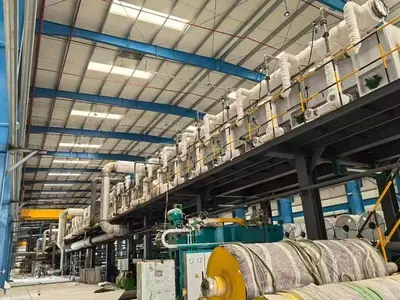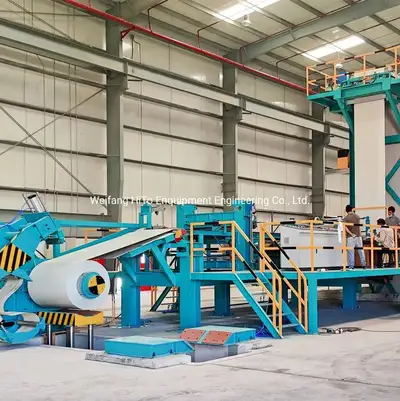Maintaining cold rolling mills represents one of the most critical yet challenging aspects of metal processing operations. HiTo Engineering has developed a comprehensive approach to maintenance that goes far beyond basic servicing to incorporate predictive technologies, precision calibration, and strategic planning. Their advanced maintenance philosophy focuses on preventing problems before they occur, maximizing equipment uptime, and extending machinery life while maintaining consistent product quality. Drawing from decades of experience with installations worldwide, HiTo's maintenance strategies blend traditional engineering wisdom with cutting-edge technology to create a holistic approach that keeps mills operating at peak performance while minimizing unexpected downtime and repair costs.
Implementing Predictive Maintenance Technologies
The cornerstone of HiTo's advanced maintenance approach involves shifting from scheduled maintenance to predictive strategies using state-of-the-art monitoring technologies. They recommend installing vibration analysis systems on critical components like gearboxes, bearings, and drive systems to detect subtle changes that indicate developing problems. Thermal imaging cameras can identify abnormal heating patterns in electrical components and bearings before failures occur. Oil analysis programs track lubricant condition and particulate contamination, providing early warning of component wear. By integrating these technologies with centralized monitoring systems, maintenance teams can address issues during planned downtime rather than responding to unexpected failures, dramatically improving overall equipment effectiveness and reducing maintenance costs by up to 25% according to HiTo's documented case studies.

Precision Alignment and Calibration Protocols
HiTo Engineering emphasizes that proper alignment is not a one-time event but an ongoing process critical to mill performance and longevity. They've developed sophisticated laser alignment techniques that ensure perfect alignment of rolls, drive trains, and backup assemblies under simulated operating conditions. Unlike traditional methods, their approach accounts for thermal expansion and operational forces that can affect alignment during production. Regular calibration of measurement and control systems is equally important, with HiTo recommending monthly verification of thickness gauges, flatness measurement systems, and tension sensors. Their documentation shows that mills maintaining strict alignment and calibration protocols experience up to 40% longer component life and significantly better product consistency than those following conventional maintenance schedules.
Advanced Lubrication Management Strategies
Proper lubrication represents one of the most overlooked aspects of cold rolling mill manufacturers maintenance, and HiTo has developed comprehensive lubrication management protocols that extend far beyond simple oil changes. Their approach includes customized lubrication schedules for different components based on operating conditions, with some high-performance bearings requiring lubrication during operation rather than during downtime. They specify specially formulated lubricants for different areas of the mill, considering factors like extreme pressure conditions, temperature ranges, and potential for contamination. HiTo's lubrication management system includes regular oil filtration, continuous moisture control, and precise monitoring of lubricant chemistry to detect degradation before it affects performance. Their data indicates that proper lubrication management can reduce bearing-related failures by up to 60% and significantly lower energy consumption.
Systematic Roll Maintenance and Management
Given that work rolls and backup rolls represent both critical performance components and significant maintenance expenses, HiTo has developed a comprehensive roll management program that maximizes roll life and performance. Their approach includes detailed tracking of each roll's service history, including hours of operation, materials processed, and maintenance performed. They've established precise grinding protocols that maintain optimal crown and surface finish while removing minimal material to extend usable life. HiTo's roll storage and handling procedures prevent damage between uses, while their inspection protocols identify microscopic cracks and defects before they become serious problems. For operations with multiple roll sets, they've implemented rotation systems that ensure even wear across all rolls, significantly reducing the frequency of roll purchases and extending the time between major regrinds.
Electrical and Control System Maintenance
Modern cold rolling mills increasingly depend on sophisticated electrical and control systems that require specialized maintenance approaches. HiTo Engineering has developed targeted maintenance protocols for these critical systems, including regular cleaning of electrical cabinets with proper anti-static equipment to prevent dust-related failures. They recommend quarterly inspections of all connections and terminations, as vibration can loosen electrical connections over time, leading to resistance buildup and potential failures. Their control system maintenance includes verification of software backups, calibration of all sensors and transducers, and thorough testing of safety systems to ensure proper operation. Perhaps most importantly, HiTo emphasizes maintaining complete documentation of all electrical and control modifications, as undocumented changes represent a leading cause of extended downtime when troubleshooting complex problems.

Comprehensive Training and Documentation Practices
HiTo recognizes that even the most advanced maintenance technologies are ineffective without properly trained personnel and thorough documentation. They've developed extensive training programs that equip maintenance teams with the skills needed to properly care for modern cold rolling equipment. This includes not only technical skills but also diagnostic training that helps technicians identify developing problems based on subtle changes in mill operation and product quality. Their documentation protocols ensure that every maintenance activity is recorded in detail, creating a valuable knowledge base that helps identify recurring issues and optimize maintenance strategies over time. HiTo has found that operations implementing comprehensive training and documentation programs experience 30% less unplanned downtime and significantly faster troubleshooting when problems do occur, maximizing overall equipment effectiveness and return on investment.
Strategic Spare Parts Management
HiTo Engineering approaches spare parts management as a strategic function rather than an administrative task, developing customized inventory strategies based on criticality analysis and lead times. They help operations identify which components require immediate availability, which can be sourced quickly from suppliers, and which can be repaired rather than replaced. For critical components with long lead times, they recommend maintaining strategic spares while implementing condition monitoring to provide maximum warning of impending failures. Their spare parts management system includes rigorous quality control for all replacement components, as substandard parts have been identified as a leading cause of premature failures and repeated downtime. By optimizing spare parts inventories based on actual failure data and risk assessment, HiTo helps operations minimize inventory costs while ensuring that critical components are available when needed, striking the perfect balance between operational security and financial efficiency.




Comments